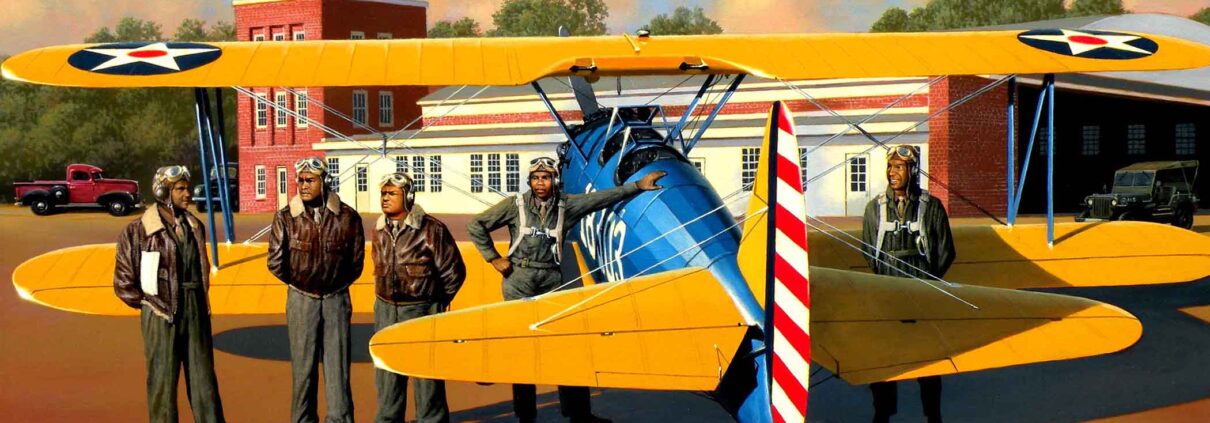Tuskegee’s First Five
Tuskegee’s First Five
Tuskegee’s first five cadets to receive their wings and become official US Army Air Force pilots were in Class 42C-SE. This group of black pilots completed their pilot training on March 6, 1942, at Tuskegee Army Air Field, in Tuskegee, Alabama. Of the 13 original cadets, five graduated (from left): Capt. Benjamin O. Davis Jr., 2nd Lt. Lemuel R. Custis, 2nd Lt. George S. Roberts, 2nd Lt. Charles H. DeBow and 2nd Lt. Mac Ross.
The setting for my painting “Tuskegee’s First Five” is Moton Field. The aircraft is the Stearman PT-17 primary trainer. Primary training was the first step in learning how to fly.
The cadets in my painting are: (left to right) Charles DeBow Jr., Benjamin O. Davis Jr., George “Spanky” Roberts, Mac Ross, and Lemuel Custis.
2nd Lt. Charles DeBow
As a fresh 2nd Lt. Charles DeBow, Jr. was assigned to the 99th Fighter Squadron and deployed to North Africa. There, the 99th pilots flew the P-40F Warhawk. Later, when the 332nd Fighter Group was deployed to Italy, the 99th was reassigned to the group. Now flying the P-51 Mustang, DeBow flew 51 combat missions.
Capt. Benjamin O. Davis, Jr.
Captain Benjamin O. Davis, Jr. had already been an officer in the US Army for several years having graduated from West Point. He became the commanding officer of the 332nd Fighter Group and much later would make it all the way to 4 star general.
2nd Lt. George “Spanky” Roberts
2nd Lt. George “Spanky” Roberts would become Davis’ second in command of the 332nd Fighter Group. On the occasions that Davis would have to go back to Washington D.C. Roberts would step in to be the CO of the 332nd. He flew more than 100 combat missions. After the integration of the armed forces in 1948, Roberts became the first African American officer to command a racially integrated unit.
2nd Lt. Mac Ross
As a 2nd Lieutenant, Mac Ross was the first commanding officer of the 100th Fighter Squadron. Having shown his leadership skills, he was then assigned the position of Group Operations Officer for the 332nd FG. He was the first of all of the Tuskegee trained pilots to have to bail out of a stricken airplane (P-40 Warhawk). Mac Ross completed more than 50 combat missions before loosing his life in an accident flying a P-51 Mustang.
Lemuel Custis
Before joining the US Army Air Force, Lemuel Custis had been Hartford, Connecticut’s first black police officer. Now as an Army Air Force pilot, he flew 92 combat missions in the P‑40 while assigned to the 99th Fighter Squadron, receiving the Distinguished Flying Cross for his heroism. After his time in combat, he returned to Tuskegee as an advanced flight instructor and was released from active military service from the U.S. Army Air Force in 1946 as a major.

 Stan Stokes
Stan Stokes Stan Stokes
Stan Stokes Stan Stokes
Stan Stokes